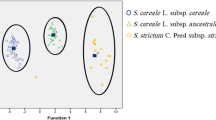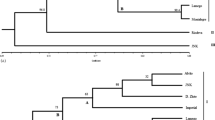Summary
The degree of inter- and intra-specific variation in the populations of allogamous and autogamousSecale L. species was estimated in support of isoenzyme markers. Totally, 11 different species ofSecale were analysed including perennial species:S. kuprijanovii Grossh.,S. chaldicum Fed.,S. montanum Guss.,S. anatolicum Boiss., and annual species:S. silvestre Host.,S. vavilovii Grossh.,S. ancestrale Zhuk.,S. dighoricum Vav.,S. afghanicum Vav.,S. segetale Roshev.; as well as the cultivated ryeS. cereale L. cv. ‘Dańkowskie Złote’. Isoenzymes were analysed in the first leaf of single young seedlings grown in controlled conditions using starch-gel slab electrophoresis technique and the electrophoretic forms of two different enzyme systems were detected: nonspecific esterases (E. C. 3. 1. 1) and peroxidase (E. C. 1. 11. 1. 7). It was found that the breeding system of rye species has a distinct affect on the isoenzyme variation in their populations. The selffertile annual species,S. silvestre, was monomorphic for both enzyme systems. A very low esterases polymorphism was also found in other autogamous species,S. vavilovii, however a similar degree of polymorphism in allogamous annual species,S. segetale andS. dighoricum, was observed. Generally, the perennialSecale species were more polymorphic than the annual ones, and the isoenzyme variation in the population of cultivated ryeS. cereale was similar to some other wild annual species. It was observed that the intra-specific isoenzyme variation inSecale was bigger than the inter-specific. Esterases electrophoretic forms showed to be very sensitive markers of variation in rye species.
Zusammenfassung
Der Grad der inter- und intraspezifischen Variation in Populationen von allogamen und autogamen Arten der GattungSecale L. wurde mit Hilfe von Isoenzymmerkmalen geschätzt. Insgesamt wurden 11 verschiedene Arten vonSecale einschließlich der mehrjährigen Arten analysiert:S. kuprijanovii Grossh.,S. chaldicum Fed.,S. montanum Guss.,S. anatolicum Boiss. und die einjährigen Arten:S. silvestre Host.,S. vavilovii Grossh.,S. ancestrale Zhuk.,S. dighoricum Vav.,S. afghanicum Vav.,S. segetale Roshev., wie auch des KulturroggensS. cereale L. cv. Dankowskie Złote. Die Isoenzyme wurden am ersten Blatt junger Einzelsämlinge, die unter kontrollierten Bedingungen angezogen wurden, unter Anwendung der Stärkegel-Plattenelektrophorese-Technik geprüft, und die elektrophoretischen Formen von zwei verschiedenen Enzymsystemen wurden nachgewiesen: nichtspezifische Esterasen (E. C.3.1. 1.)und Peroxidase (E. C. 1. 11. 1. 7.). Es wurde gefunden, daß das Fortpflanzungssystem der Roggen-Arten eine bestimmte Wirkung auf die Isoenzymvariation in ihren Populationen hat. Die selbstfertile einjährige Art,Secale silvestris, war hinsichtlich beider Enzymsysteme monomorph. Ein sehr schwach ausgeprägter Esterasenpolymorphismus wurde in einer anderen autogamen Art,S. vavilovii, gefunden, jedoch wurde ein ähnlicher Grad von Polymorphismus in allogamen einjährigen Arten,S. segetale undS. dighoricum, beobachtet. Grundsätzlich waren die mehrjährigenSecale-Arten polymorpher als die einjährigen, und die Isoenzym-Variation der Populationen des kultivierten RoggensS. cereale war ähnlich der einiger anderer einjähriger Wildarten. Es wurde beobachtet, daß die intraspezifische Enzym-Variation vonSecale größer war als die interspezifische. Die esterase-elektrophoretischen Formen erwiesen sich als sehr empfindliche Indikatoren für die Variation der Roggenarten.
Краткое содержание
Степень межвидовой и внутривидовой измен чивости в популяциях аллогамн ых и автогамных видов ро даSecale L. оценивалась при помощи признаков изоэнзимов. Всего ана лизировалось 11 различ ных видов; многолетние:S. kuprijanovii Grossh.,S. chaldicum Fed.,S. montanum Guss.,S. anatolicum Boiss.; однолетние: S. silvestreHost,S. vavilovii Grossh.,S. ancestrale Zhuk.,S. dighoricum Vav.,S. afghanicum Vav.,S. segetale Roshev. и культур ная рожьS. cereale L., сорт ‘Даньковские Злоте’. Изоэнзимы исследовались в перв ом листе отдельных моло дых сеянцев, выращенн ых в контролированных ус ловиях, с применением методи ки электрофореза (кра хмал — гель). Были выявлены электрофоретически е формы двух различны х систем энзимов: неспецифиче ские эстеразы (Е. С. 3. 1. 1.) и перок сидазы (Е. С. 1. 11. 1. 7.). Оказалос ь, что система размножения видов рж и оказывает определë нное влияние на изменчивость изоэнзимов в их попул яциях. Самофертильны й однолетний видS. silvestre был мономорфен в отно шении обоих систем эн зимов. Очень слабо выраженный полиморф изм эстераз был найде н у другого явтогамного вида,S. vavilovii, однако сходная сте пень полиморфизма наблюдалась и у аллог амных однолетних видов,S. segetale иS. dighoricum. В общем, многолетни е виды ржи оказались более п олиморфными, чем одно летние, а изменчивость изоэнз имов популяций культурно й ржи была сходна с так овой некоторых других однолетних дикораст ущих видов. Внутривид овая изменчивость энзимо в у родаSecale оказалась силь нее, чем межвидовая. Электроферетически е эстеразные формы проявили себя к ак очень чувствитель ные индикаторы изменчив ости видов ржи.
Similar content being viewed by others
Literature
Arroyo, M. T. K. de, 1975: Electrophoretic studies of genetic variation in natural populations of allogamousLimnanthes alba and autogamousLimnanthes floccosa (Limnanthaceae). - Heredity35, 153–164.
Babbel, G. R. andR. P. Wain, 1977: Genetic structure ofHordeum jubatum. I. Outcrossing rates and heterozygosity levels. - Can. J. Genet. Cytol.19, 143–152.
Brown, A. H. D., 1978: Isozymes, plant population genetic structure and genetic conservation. - Theor. Appl. Genet.52, 145–157.
—, 1979: Enzyme polymorphism in plant populations. - Theor. Popul. Biol.15, 1–42.
Gottlieb, L. D., 1974: Gene duplication and fixed heterozygosity for alcohol dehydrogenase in the diploid plantClarkia franciscana. - Proc. Nat. Acad. Sci. USA71, 1816–1818.
—, 1977: Electrophoretic evidence and plant systematics. - Ann. Mo. Bot. Gard.64, 161–180.
Graham, R. C., U. Lundholm, andM. J. Karnovsky, 1965: Cytochemical demonstration of peroxidase activity with 3-amino-9-ethylcarbazole. - J. Histochem. Cytochem.13, 150.
Jaaska, V., 1975: Evolutionary variation of enzymes and phylogenetic relationships in the genusSecale L. (in Russ.). - Eesti NSV Tead. Akad. Toim. Biol.24, 179–198.
—, 1979: Genetic polymorphism of acid phosphatase in population of rye,Secale cereale L. s.l. - Eesti NSV Tead. Akad. Toim. Biol.28, 185–193.
Jacobs, M., 1975: Isozymes and a strategy for their utilization in plant genetics. II. Isozymes as a tool in plant genetics. - In: Genetic manipulations with plant material (Edit.L. Ledoux) pp. 379–389. Plenum Press, New York.
Johansson, H., 1969: Multipla enzymformer i råg. - Nord. Jordbr. Forskn.51, 123–124.
Kahler, A. L., R. W. Allard, M. Krzakowa, C. F. Wehrhahn, andE. Nevo, 1980: Associations between isozyme phenotypes and environment in the slender wild oat (Avena barbata) in Israel. - Theor. Appl. Genet.56, 31–47.
Kristjansson, F. K., 1963: Genetic control of two pre-albumins in pigs. - Genetics18, 1059–1063.
Marshall, D. R., andR. W. Allard, 1970: Isozyme polymorphism in natural populations ofAvena fatua andA. barbata. - Heredity25, 373–382.
Morishima, H., andH.-J. Oka, 1970: A survey of genetic variations in the populations of wildOryza species and their cultivated relatives. - Jap. J. Genet.45, 371–385.
Puchalski, J., andB. Molski, 1975: Esterases variability within some Polish rye cultivars. - Hod. Rośl. Aklim. Nasien.19, 479–485.
Schmidt-Stohn, G., 1979: Genetische Analysen von Esterase-Loci beim Roggen (Secale cereale L.) mit Hilfe der isoelektrischen Fokussierung in Flachgelen. - Z. Pflanzenzüchtg.83, 155–162.
Shahi, B. B., H. Morishima, andH.-J. Oka, 1969: A survey of variations in peroxidase, acid phosphatase and esterase isozymes of wild and cultivatedOryza species. - Jap. J. Genet.44, 303–319.
Shaw, C. R., andA. L. Koen, 1968: Starch gel zone electrophoresis of enzymes. - In: Chromatographic and electrophoretic techniques. - Vol.II. Zone electrophoresis (Edit.I. Smith) pp. 325–364. Heinemann Med. Books, London.
—, andR. Prasad, 1970: Starch gel electrophoresis of enzymes — a compilation of recipes. - Biochem. Genet.4, 297–320.
Author information
Authors and Affiliations
Additional information
Presented as poster
Rights and permissions
About this article
Cite this article
Puchalski, J., Molski, B. Isoenzyme variation within the wildSecale L. species. Die Kulturpflanze 29, 391–399 (1981). https://doi.org/10.1007/BF02014768
Issue Date:
DOI: https://doi.org/10.1007/BF02014768




